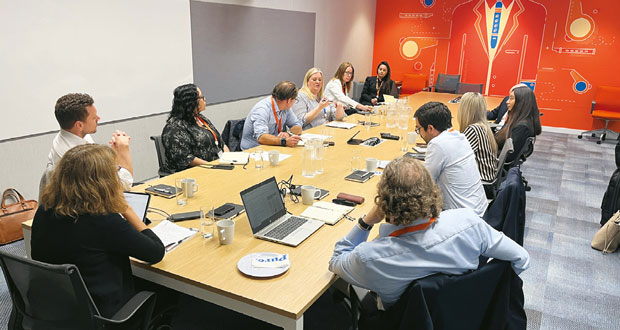FMJ brought recruitment experts from Indeed Flex together with a group of talent, procurement and tech thought leaders from the FM sector to discuss AI and people: the top tech led solutions to help address a recruitment crisis
• Sara Bean, Editor FMJ
• Alison Fitzer, Business Development Director, Indeed Flex
• Lauren Gilflin, Senior National Business Development Manager, Indeed Flex
• Kelly Dolphin, Chief People & Culture Officer, SBFM
• John Hamilton, CPO, Bellrock
• Adam La Faci, Head of Talent Acquisition in the UK, CBRE
• Danny Heaton, HR/TA Team, Sodexo
• Noah Price, Head of Academy, G4S
• Jade Collazo, HR Director, Cleanology
• Kelly Holt, CCO, Pareto FM
• David Hemming, Consultant, Major Programmes, NHS Estates
FM businesses have long used temporary staff to manage fluctuating workloads, but with a rise in National Insurance Contributions (NICs) and increasing fixed labour costs it’s predicted that this demand will only rise. As Alison Fitzer, Business Development Director, Indeed Flex explained: “There’s a big shift towards hiring flexibility, as employers are slowing down their permanent hiring processes and leaning more on the flexible staffing side, mainly because of the agility with that approach, but also because of the rising costs of permanent employment.”
But how can employers find, recruit and deploy a temporary workforce while ensuring they are fully trained, managed and kept safe? According to a White Paper by Indeed Flex the adoption of AI forecasting tools will enable employers to predict staffing needs, close skills gaps and proactively plan for seasonal demands.
Fitzer explained that by reducing reliance on last-minute hiring, these tools cut costs and ensure seamless operational continuity. “Organisations are really taking on board the fact that they must streamline the way that they do things, which includes adopting new tech platforms to help manage a flexible workforce,” she said. “This is helped by having that visibility in the cost control and the compliance [with AI] as well.”
COST CHALLENGES
Quizzing delegates on the rise in NICs, most agreed the changes are impacting an industry already coping with tight profit margins, where having access to staff that are able to pick up whatever shifts suits them works well.
Another participant noted that with the cost of living being so high, their clients are looking to save money where they can. One explained that in the cleaning sector which, sadly, is still not respected as it should be, it’s the first place they look. “We were asked to reduce costs, with the expectation on the worker being that they will then still complete the same output for them on reduced hours.”
This can disadvantage the many cleaning staff for which the role is not even their primary job said a delegate. “They’re often filling in as they’re already working other jobs, and they clean for the flexibility it affords.” It was also pointed out that despite L&G’s Hidden Workers campaign, which recommends paying a Real Living Wage, paid sick pay and insurance, some clients are resistant: “Which prompts us to think about whether they’re the sort of clients we want to work for, because we don’t want to be that kind of employer.”
The other cost headache is rising inflation, where low paid workers are most affected. One supplier explained that their frontline staff had a 20 per cent rise in the space of about 13 months, by being moved from the minimum wage to a Real Living Wage – then the following year, the Real Living Wage went up 10 per cent again. “That was a killer for our soft services business, because the majority of the cost is people cost, and the majority of the margin was wiped out, so the high cost of living has been huge.”
FLEXIBLE STAFFING
Increases in fixed labour costs drives employers towards flexible staffing, explained Lauren Gilflin, Senior National Business Development Manager, Indeed Flex. “Businesses need high quality and skilled workers faster than ever before, and I think the use of technology is harnessing that enablement so they’re able to reach them a lot faster than they would have in other realms. Tech is also enabling cost agility, so they’re able to see their costs and their outgoings, when it comes to managing temporary staff as well.”
We moved on to discuss the key areas where facilities managers supplement their team with flexible staff; from managing events where the workforce is going to be transient to periods of time where staffing levels may fluctuate for a few days or a few weeks. This can be applied to white collar job roles. For instance, by hiring consultants to come in on fixed term contracts to help mobilise new service contracts.
Given all these scenarios we turned to the advantages of using AI to hire staff. Fitzer explained that with automated screening. “AI agents do a lot of the hard graft work at the beginning and then the human element comes in after that.”
Currently, while candidates and employers may be approaching AI with some trepidation, as Fitzer pointed out: “Right now, is the worst AI will ever be. Yet even though some things aren’t going to be perfect, and we’ve still got a long way to go – for recruiters and candidates – the tech can only get better.”
There were also concerns among the group whether AI is, as often promoted – unbiased: “AI is written by people who’ve got a bias who are drawing on existing data sets, so they’ve already got inherent bias in them. I really worry about it from an EDI perspective, because it will be filtering out people who answer questions in a certain way.”
However, as our AI expert panellist pointed out: “We are right at the start of this journey with the most amazing technology ever invented. Right now, AI can do three things. It can be advisory, supervisory or controlling, and that is dependent on what it is you’re trying to do and how much you trust it. It is currently a very intelligent assistant, but we still need humans in the loop. This is why we must use it in a very controlled manner in an advisory function and then start to maybe move into supervisory and controlling levels.”
A huge advantage for talent managers said Gilflin is in using AI for predictive analysis, being able to predict trends of how the market is going and what kind of gaps are going occur in a workforce: “Using AI to get that information is going to be a lot faster than from a human and I think that’s where the benefits of AI can come in in areas like workforce planning and optimising staff deployment.”





